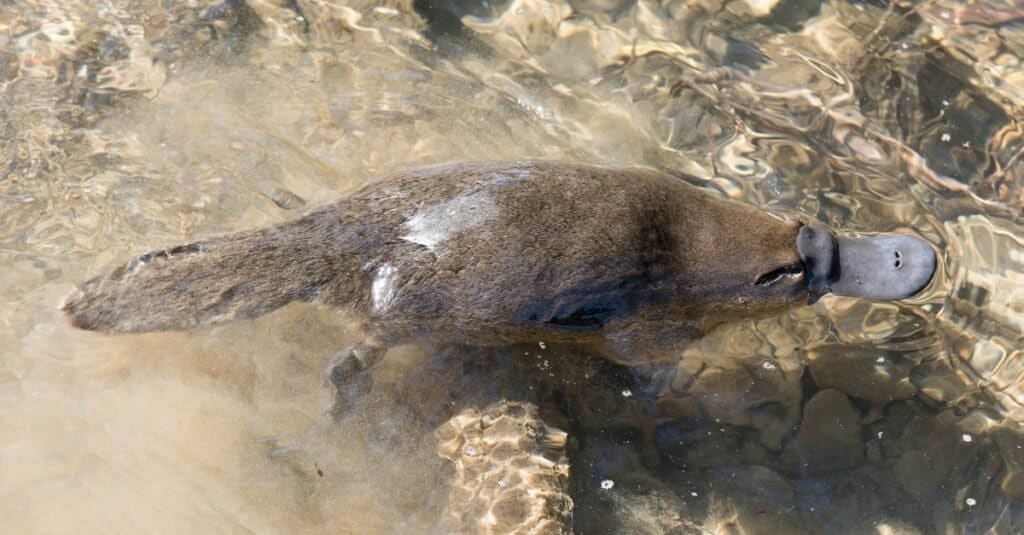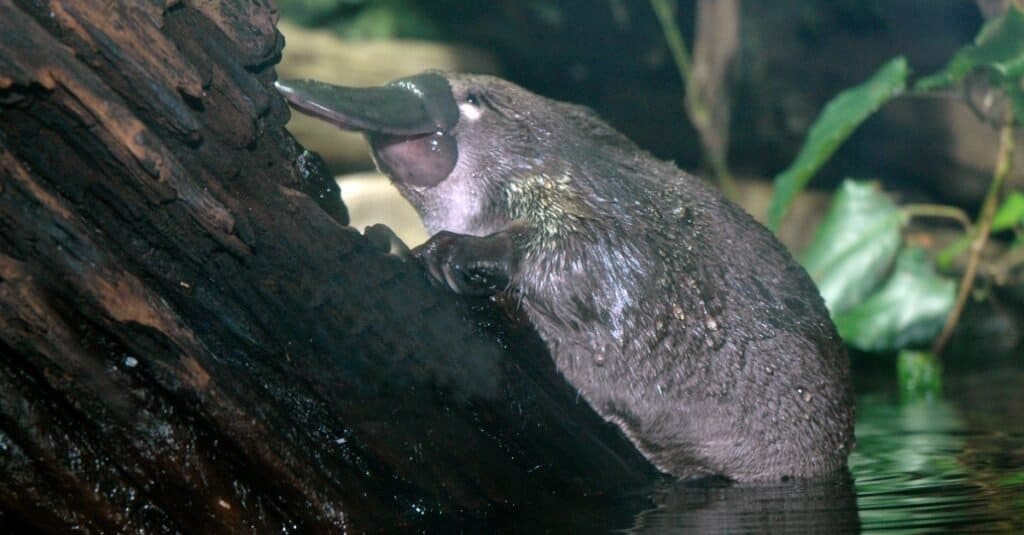Few animals on earth are as intriguing and confusing as the platypus. There have been countless debates about the taxonomical status of these unique creatures since they were first discovered. Because the have fur, they were considered mammals. Given that they lay eggs rather than have live births, this was disputed. When it was discovered that the females do indeed produce milk to feed their young, they were once again classified as mammals.
At first glance, the platypus looks like a strange hybrid animal straight out of Greek mythology. When it was first described by zoologist George Shaw around 1800, many of his peers thought it was a hoax. They even checked the original platypus specimen for stitching. When the science of taxonomy was still growing, the animal seemed to blur the lines between different classifications. We now know that this small semi-aquatic mammal, which can be found in the freshwater rivers and estuaries of eastern Australia and Tasmania, belongs to an order of animals called the monotremes.
Besides the platypus itself, there are only four other species of monotremes left on the planet, all of which are echidnas (also known as spiny anteaters). They form an entirely separate evolutionary branch, distinct from placental mammals and pouched marsupials, with which they last shared a common ancestor some 166 million years ago. The fossil evidence suggests that the monotremes were once the dominant form of mammalian life in Australia and may have spread as far as South America.
The main turning point which caused their decline was probably the arrival of marsupials some 71 million to 54 million years ago from continental Asia. The marsupials had several advantages over the monotremes and probably outcompeted them for resources.
As the descendent of these surviving monotremes, the platypus is really like no other animal on the planet. Its reproduction is a unique fusion of mammalian and reptilian characteristics. It has 10 different sex-determining chromosomes, as opposed to only two in humans and other mammals.
The platypus defends itself with highly potent venom, which the male delivers through sharp spurs located on the ankles. This venom contains chemicals largely unique to the platypus. Even its bill only shows a superficial resemblance to the duck; it’s actually filled with electric sensors that enable it to navigate underwater even when it lacks sight.
Despite these eccentric characteristics, born from its different evolutionary path, the platypus bears all the hallmarks of mammalian ancestry. This article will explore the six major characteristics that the platypus shares in common with most other mammals. Some of the similarities are expected, but a few of them might be surprising.

.
©iStock.com/JohnCarnemolla
The platypus has mammary glands
Perhaps the most important mammalian feature is the milk-producing mammary glands that the female platypuses possess to feed the young. The name “mammal” is a testament to the importance of these glands in the classification and identification of the entire mammalian class. But the reproductive behavior of the platypus is so much stranger than that. Whereas all other groups of mammals still living on the planet give birth to live young, the monotremes are distinguished by their ability to produce eggs instead. The name monotreme itself means “single opening.” This refers to the single duct through which it urinates, defecates, and reproduces.
The first part of the reproductive process is similar to a reptile. After a pair of platypuses mate, the female produces a few small, leathery eggs, which spend about 28 days inside of her body and then another 10 days being incubated externally. The developing embryos rely on the yolk for sustenance.
After the eggs are finally hatched, however, the mother will begin producing milk for her young. Milk production is an interesting process. Since the female lacks teats of any kind, the milk leaves the body through skin pores in the abdomen. Interestingly, the milk contains powerful antibiotics to protect the young from infection. This may have powerful applications for future human antibiotic use. The young are weaned for three to four months after hatching from the eggs and become independent a short time later. No other animal on the planet besides maybe echidnas reproduce and raise young exactly in this manner.
The platypus has fur
Mammals are the few animals on the planet that possess true fur for the purpose of insulation. The platypus is no exception. Both the body and the beaver-like tail of the platypus are covered in dense brown waterproof fur (many thousands of hairs per square inch) that enables it to trap air and keep it warm. The fur is so dense and luxurious that the platypus was once hunted by colonists in Australia to make clothing. This practice continued until the platypus was given formal protection by the Australian government in the early 20th century.
The fur is fascinating from a scientific perspective as well. In 2020, researchers discovered that the platypus fur actually glows with an eerie blue-green light when subjected to the glare of an ultraviolet lamp. It does this by absorbing light during the day and then emitting it again at a different color. While this is a common phenomenon in many animals without fur, including reptiles, amphibians, fish, and birds, it’s relatively rare in mammals (though scientists are finding more exceptions every year, including flying squirrels and Tasmanian devils). It’s not clear what purpose this serves – or if it serves any purpose at all – but it’s a fascinating phenomenon nonetheless.
The platypus is warm-blooded
Warm-blooded (also known by the scientific term of endothermy) refers to the ability of an organism to raise its body temperature above that of the surrounding environment. While not every mammal is able to perfectly regulate its body temperature in this manner, it is still a common feature of most mammals. The platypus is no different in this respect; it produces enough heat via its metabolism to keep warm and comfortable even in cold waters. It does, however, have a lower average body temperature of about 90 degrees Fahrenheit, as opposed to the 99-degree body temperature of most mammals. This may be an adaptation to life in harsher environments.
The platypus has a four-chambered heart
Mammals and birds are the only animals on the planet that possess a four-chambered heart; fish only have two chambers, and amphibians and reptiles only have three. The four-chambered heart has an enormous advantage with its ability to separate the oxygen-rich blood coming out of the lungs from the oxygen-poor blood traveling to the lungs. This more efficient circulatory system enables greater physical activity and fewer periods of rest by supplying the cells with more oxygen-rich blood overall.

©iStock.com/Michel VIARD
The platypus has a mammalian skeletal structure
Humans, whales, elephants, and platypuses may look vastly different, but they all share in common a similar skeletal structure. One of the most important features of the mammalian skeleton is the lower jawbone; it is composed of a single piece of bone that attaches directly to the skull. Most other vertebrates have multi-piece jaws instead. Mammals also have three small ear bones that transmit sound vibrations from the eardrum to the inner ear, where they’re transformed into neural impulses. It’s believed that these ear bones evolved from the lower jawbones of the earlier reptilian ancestors.
These are all traits that the platypus share in common. However, there are a few key differences between the platypus and most mammals. The platypus has a more reptile-like gait because the legs are located on the side of the body rather than underneath. They also have extra bones in the shoulder, which few other mammals possess.
The platypus possesses sweat glands
Mammals possess glands over most or parts of their bodies. While humans are one of the few animals that sweat to cool down, most mammals still use these glands for different purposes. As mentioned earlier, the platypus female quite literally sweats milk from the abdomen to feed her young. Scent marking is also another important use of these glands.
Summary
While there still remains some debate over how to classify these odd animals, they are considered to be mammals (for now anyway). The platypus remains one of the most fascinating creatures we have. They have inspired countless would-be biologists and provide endless speculation. Like all other animals though, they go about their lives and don’t worry about how we classify them.
Up Next…
- Platypus Teeth: Do Platypus Have Teeth? They have a duck-like bill filled with electric sensors that help them navigate, but do they have teeth? Find out here.
- Are Platypuses Poisonous or Dangerous? The males have venom. What about the females? Are they dangerous to people or just other platypuses? So many questions! Learn more about them here.
- What Does The Platypus’ Eat? What does a semi-aquatic mammal who lays eggs eat for dinner? Check out this article to find out.
The photo featured at the top of this post is © iStock.com/Michel VIARD
Thank you for reading! Have some feedback for us? Contact the AZ Animals editorial team.






